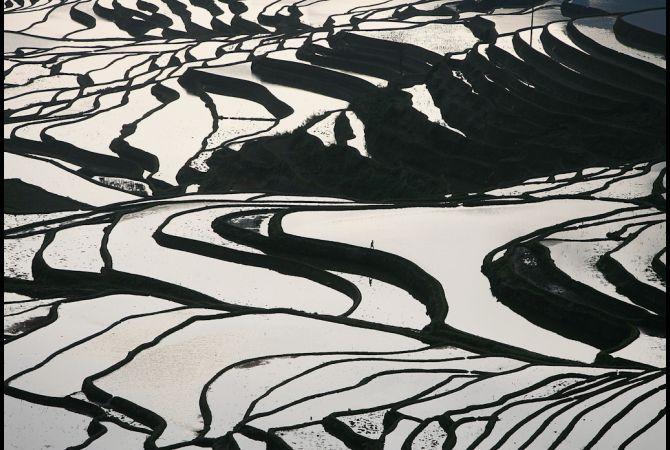Rice 2.0: Toxic rice in China
A farmer of the Hani ethnic group works at the terraces in Yuanyang County, Yunnan Province, China. Feb. 10, 2006.
Editor's note: Of the world's 50,000 edible plant species, only a few hundred find their way to menus around the globe. Of those, just three — rice, wheat and maize — make up two-thirds of the human food supply. And only rice is responsible for feeding half the world, or more than 3.5 billion people.
In other words, rice is important. So important, in fact, that a tweak to the way rice is grown, sold or eaten can send ripples through the world economy. Earlier this year, government subsidies for rice in Thailand, where 30 percent of the world's crop originates, did just that. Prices everywhere shot up, though it looks like any looming instability has been offset by other exporters, namely India, steadying the market.
Still, the point is rice in one place affects millions. In Indonesia, Suharto coaxed a people into growing the grain and changed a culture. In India, the genetically modified golden rice could save millions of lives and, yet, may never get into the ground. Rice 2.0 is GlobalPost's look at a tiny grain with a giant footprint.
BEIJING, China — Xu Limin goes out of her way to make sure the rice she buys wasn’t grown in southern China.
“I’m not too picky about every single food item, but rice is the most important thing, so I want the cleanest,” said Xu, a 28-year-old office worker in Beijing, chatting as she shopped for groceries in an organic supermarket.
“Everyone knows rice from the south might be contaminated so I want rice from the north, or even something imported.”
On a scale of China’s food safety issues, pollution-tainted rice might just be the biggest problem of all. Rice is the country’s national staple, a grain deeply intertwined with history, culture and all things Chinese.
Though rice farming is on the decline as the country grows wealthier and more urban, China still produces almost one-third of the world’s rice. It is also the No. 1 consumer of rice.
So when reports came out earlier this year indicating that up to 10 percent of China’s domestically grown rice, and a total of 12 million tons of all grains, might be contaminated by heavy metals in polluted soil, consumers were understandably worried.
More Rice 2.0: Happy farmers, hungrier planet?
Many, like Xu, said they heard rumors about tainted rice for years. Xu says she wasn’t shocked by the reports, but they did confirm her suspicions and make her more willing to search for specific, potentially more expensive rice.
Of course, as with most other foods in China, it’s almost impossible to tell for certain where something was grown and whether it might be contaminated with some sort of toxin.
“Rice from the north is shorter, denser and tastes a little earthier,” Xu said, elaborating on her own personal system for selecting rice.
More Rice 2.0: Is rice the enemy?
The toxic rice reports gained traction in February, when Chinese media highlighted scientific studies showing that up to 10 percent of rice grown in China contained cadmium. The toxic heavy metal was presumably deposited onto southern China’s fertile farmlands through years of industrial waste and sewage disposal.
Chinese investigative magazines highlighted several cases in which whole villages were affected by tainted rice crops. In one village in Guangxi province, farmers described painful details of what sounded like cadmium poisoning, including severe bone and joint pains. Cadmium poisoning can also lead to kidney failure.
Public outcry over the tainted rice news died down fairly quickly, however, after the government promised substantive steps to fix the problem. Yet the broader health impacts remain unknown.
These days, the scientists at Nanjing Agricultural University who conducted the landmark rice study in 2008 refuse to talk about it any further, saying that the information has been released publicly and there is nothing to add.
Chinese food-safety experts say tainted rice is only the tip of the iceberg and points to wider problems in China’s food supply.
Guo Hongwei, a food and nutrition researcher at Shanghai’s Fudan University, said contaminated rice is a tricky topic to tackle because pollution levels are highest at the source, on farms, and it’s tough to tell what affect the rice might have on consumers at the end of the chain.
Fan Zhihong, a well-known food-safety advocate, said contaminated rice is a dangerous warning sign.
“You can't tell by vision and you can't even taste it,” said Fan. “It's up to food-safety agencies to take care of this. But items like cadmium are not always checked during regular monitoring, which makes it more dangerous since nobody is watching it.”
Rice’s position as the staple food for nearly two-thirds of China’s population means consumers can’t easily switch to something else when they fear a problem.
“It's hard to replace rice,” Fan added. “You could switch to another kind of fruit or fish if one type is reported to have been polluted. But you don't go far without eating rice.”
Fan said the solution lies in better-informed citizens and environmental protection. If consumers understand the link between pollution and food problems, they’ll begin to take more interest in underlying environmental issues.
The article you just read is free because dedicated readers and listeners like you chose to support our nonprofit newsroom. Our team works tirelessly to ensure you hear the latest in international, human-centered reporting every weekday. But our work would not be possible without you. We need your help.
Make a gift today to help us raise $67,000 by the end of the year and keep The World going strong. Every gift will get us one step closer to our goal!
